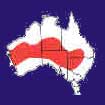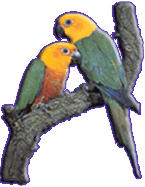|
|
| |
|
|
|
|
RED – RUMPED PARROT (SINGING PARROT)
Psephotus Heamatonus |
|
|
| They come from south-east Australia , but they can also be found in south Qweensland and Victoria. They make nests in hollow trees, trunks, and even below roofs and similar places. They are 27-28cm long, and comparing to other parrot species the difference between sexes is obvious even with very young birds in the nest. Females are grayish – green, while males have fluorescent green head and throat, green back and tail with little green. Brest is intensive yellow and lower back is bright red, wings are green with dark blue edges, e.g. primary flying feathers. |
 |
Besides basic coloration there is a pastel yellow mutation, present even in our country (in aviaries of our breeders), multicolored mutation, and in last few years, in Germany and Belgium there was a success in breeding an intensive yellow, blue and white mutations. Unfortunately, these mutations are unavailable in our country due to their high prices and the inability to import them. |
|
| |
|
|
A pair of red-rumped parrots; pastel mutation
Female is brighter – left, male - right |
|
| |
|
With budgerigars and cockatiels excluded, most frequently kept species in aviaries of our aviculturists is the red-rumped parrot. They are very worthwhile for breeding beginners due to their especially nice character and modest diet as well as for easily spotted difference in sexes with very young birds (though the color intensity is slightly less than in mature birds). Young birds are reproductive and ready to mate in 6-8 months. Older and more experienced breeders use this parrots for breeding rare species by planting the eggs. The red-rumped parrots are excellent parents and they easily breed other parrots' young until they mature. |
|
|
Female hatches 4-8 white eggs in the hollow trees and incubates them for 20 days. The eggs are 19x24mm. She feeds the young with lot of care and almost never leaves the nest. The male gives the halfdigested food to the female, then she digests the food a bit more and only then she feeds the young. The fledglings leave the nest 4 weeks after hatching and the male feeds them for the next 2 weeks. They make very pleasant sounds which are various and not noisy at all. That is how they got their name. They are said to be “canaries in the body of parrots”. |
| male of the red-rumped parrot
|
|
| |
Basic diet consists of oats, millet, sunflower, canary seed, dandelion leaves, spinach, carrot, apple and leaves with parsley twigs. The diet for the young should be supplemented with mixture consisting of boiled and grated eggs, grained biscuits and poppy. They also need vitamins and minerals, and in my experience the best mixtures are those made by “Vitamineral” from Belgium and “Vitakraft” from Austria, but these can also be purchased with renowned breeders who take care of health and visual appearance of their pets.
When living in nature, the red-rumped parrots don't change their partners and they mutually clean each other feathers with their beaks, which is a rare behavior for birds that inhabit Australia. |
|
|
A pair of red-rumped parrots
(left - female, right- male)
|
They are not liable to digestive tract parasites, so there is no need for preventive medicines, but no matter how the seed is clean it always have a small amount of dust, so few times a year the bird should be given a solution of potassium permanganate for clearing the respiratory tract.
As a pet, the red-rumped parrot is very worthwhile, because of its size (they don't need big cage), its pleasant character since it doesn't bite (as most parrots) and what is most important, they make lovely but not noisy sounds. It is important to add that this kind of parrot should be kept in pair, only then their song reaches its full beauty.When kept single they tend to be melancholic. |
|
|
| |
|
|
|
| |
|
|
|
|
|

